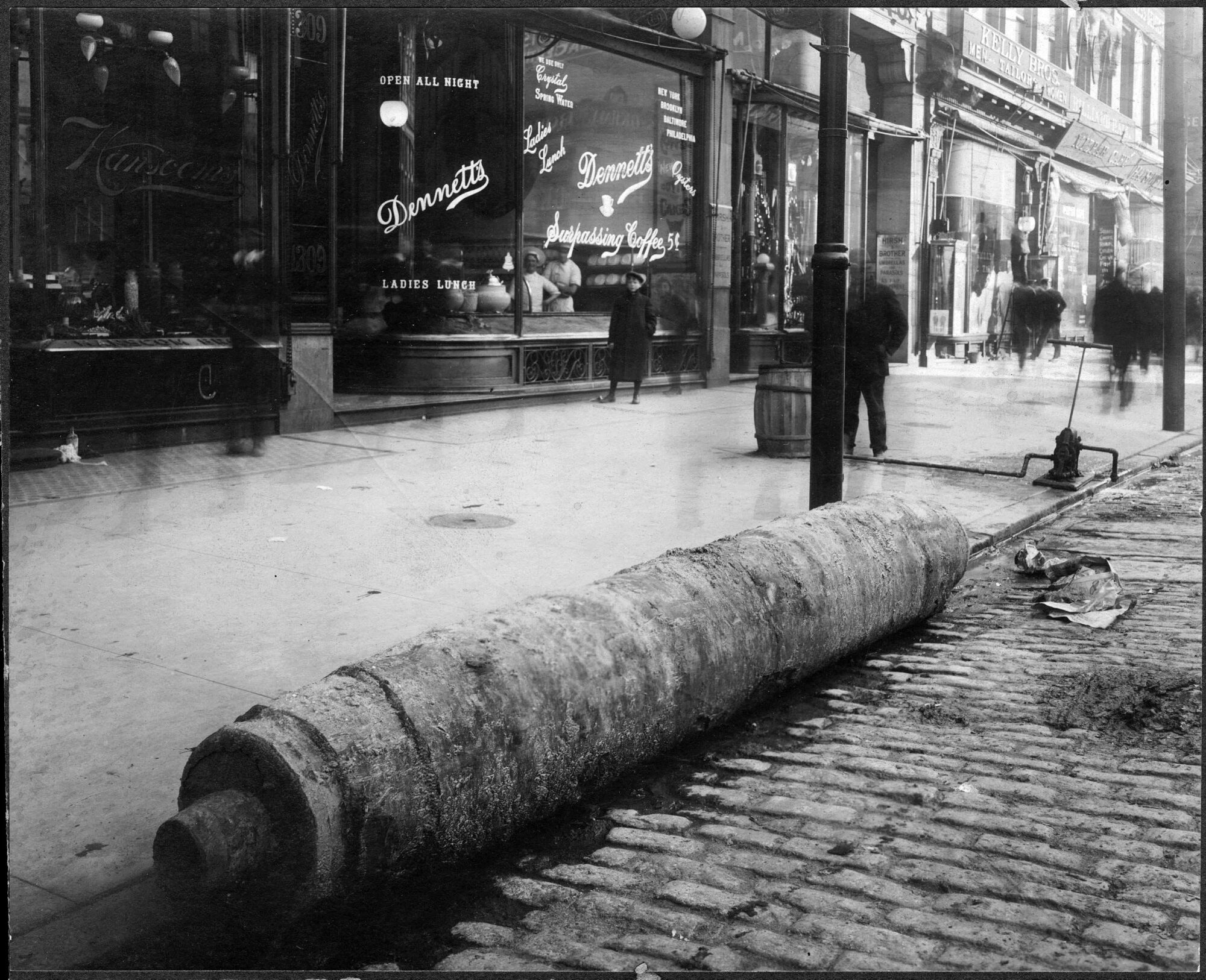Since I am regularly asked about the use of wooden pipes in Philadelphia’s water and sewer systems, I’ll try here to provide some basic information. For a broader vew of these systems, and how the pipes and other aspects of them evolved over time, you can peruse the Water and Drainage History Course on this site.
NO WOOD FOR SEWERS Even the earliest underground sewers in the city, built probably in the 1720s, were made of brick. Depending on their sizes (which can range from about 8 inches to 20 feet in diameter) sewers might also be made of terra cotta, vitrified clay, granite (or Belgian) block, PVC plastic, precast concrete, and reinforced concrete cast in place.
Early in the city’s history, rectangular wooden pipes (called trunks) were sometimes built across intersections to carry water flowing in gutters from one side of the street to another, so pedestrians and horses didn’t have to wallow the pooled-up water during wet weather. And occasionally a wooden trunk would be run through the underpinnings of a wharf, to carry the sewage out farther into the river where it would be more quickly dispersed by the flowing water. But both these solutions were not common, and were only temporary fixes until more permanent pipes could be built.
WOOD WAS FOR WATER Wooden water pipes (also called water mains) were laid in Philadelphia from the beginning of municipal water service in 1801. Cast-iron was considered, but at that date there was no iron foundry in the area that could produce enough pipe for the city’s needs. The wooden pipes used to distribute the water were fashioned from sections of tree trunks cut to about 12 feet long. White oak, yellow pine and spruce were commonly used for this so-called “pipe timber.” Each log was bored through its center with an auger to make hole either 3, 4.5, or 6 inches, to make a hole for the passage of water. The bored logs were joined into pipelines with iron couplings and straps, some of which are illustrated in the gallery below.
By 1820 the iron industry had progressed in capacity and expertise, and the city began laying cast-iron pipes in earnest. At that point the city still had a inventory of wooden pipes that they continued to install until 1832. Over the next 26 years, the city began replacing the wooden mains with cast iron. The 1858 report below, from Henry P. M. Birkinbine, chief engineer of the Water Department, notes the end of the wooden pipe era:
“The last of the old wooden pipes in use for water mains have been taken up and iron pipe substituted. These were laid from Arch to Vine on the east side of Broad street, and from Filbert to Vine on the west side of Broad street, and on the south side of Vine from Broad to Fifteenth street. The logs taken up were in a remarkable state of preservation, and would have probably answered for many years had it not been for the steam engines which have lately been attached to them for their supply, since which time they have been a constant source of annoyance and expense. Up to 1832, the city had laid 241,604 feet [45.76 miles] of wooden pipe, since which time none have been laid, and that which was laid has been gradually substituted by iron pipe. At first, wooden pipe was thought superior to iron, and was used entirely until 1804, when 3,978 feet of the latter were laid; but from that time until 1818 none but wooden pipe was used. In that year 400 feet of iron pipe were laid, and in 1820 the committee on water became satisfied from their experience that they were not only as good as wood, but, in fact, better. Iron pipes were therefore substituted for the wooden ones; they were found not only stronger but more durable, easier laid, and less expensive.” (Department for supplying the city with water. Annual Report [for 1858] of the Chief Engineer of the Water Works of the City of Philadelphia. Philadelphia: Collins, Printer, 1859, page 18.)
This later overview of wooden pipes, published in a local engineering journal in May 1884, goes into more detail about the connections between the pipe sections, the types of wood used, and how well the pipes held up over long use.

PIPES STILL FOUND An unknown number of wooden water pipes were left in the ground when the new cast iron pipes were installed, and they are occasionally dug up by workers digging in the streets. If this discovery of old infrastructure goes public, a flurry of media inquiries usually results. The last time was in May 2017, and stories ran in a number of publications and podcasts, including this from the Washington Post.













